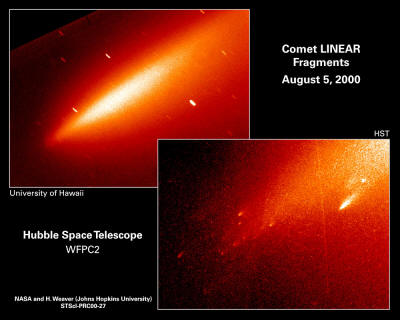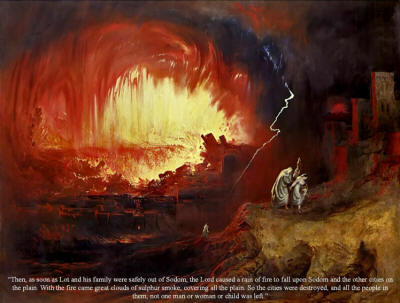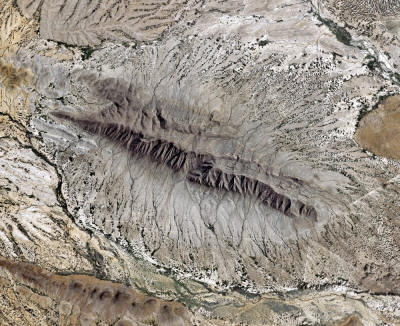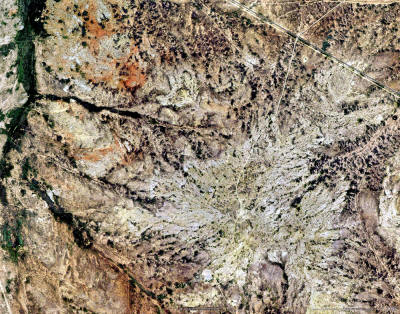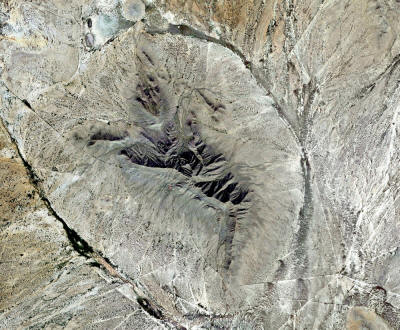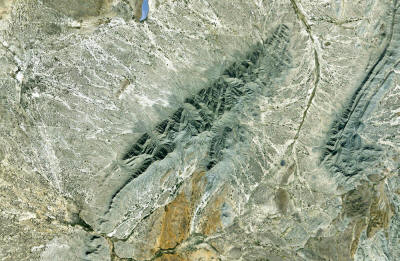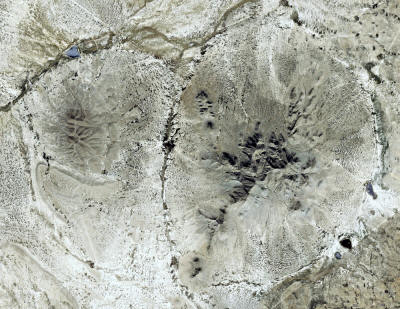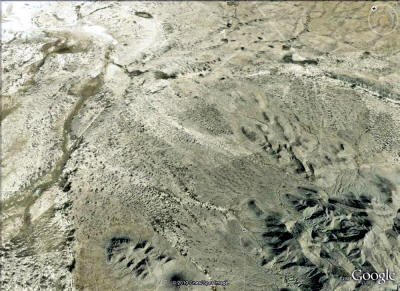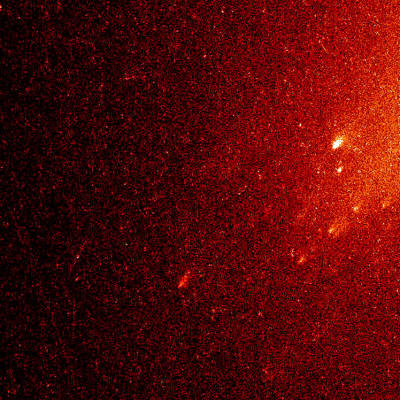|
from DragonStormProject Website
A long time ago, when the first LandSat images became available to the general public, I noticed some explosive blast effects that, in light of the new image data, couldn't be believably explained by standard geology theory. At the time, I knew nothing of the Younger Dryas cooling.
And it was before any talk of a proposed impact event at the end of the last ice age.
But it was a wonderful conundrum.
I knew I was looking at the results of a continental scale natural disaster that flew in the face everything I had ever learned. I knew of no natural energy release to account for the scale of blast effected materials I was looking at. And for that matter, I knew of no kind of energy release at all that could do what I was seeing.
It confirmed, if nothing else, that an event of the level of destruction I was considering did indeed happen.
And recently enough too.
Or to put it more simply: We must get hit about six times more often than the moon, and by bigger objects. All of the landforms on the moon, every mountain range, every depression, every feature you can see, are impact related. Anyone with a toy telescope can look up on a clear night and see whole mountain ranges that were raised up in seconds sometime in the past.
The study of astronomy gives us a
pretty good idea of the frequency of the various sizes of impacts.
And anyone can look at the erosion of land forms here on Earth and
see how slow that process is.
And yet, there is not a single accepted
theory that allows for extra-terrestrial events as one of the
possible driving forces in landform creation.
But the firestorm of mass extinction impacts that wiped out North America a few thousand years ago did happen. We have the burned bones of the corpses for proof. And we have other materials that tell us conclusively of the heat and pressure that must have happened at some places in the firestorm. Such heat and pressure as is only found in an ET impact event.
Those specific materials are the nano-diamonds found in the Younger Dryas Boundary layer (YDB) - Kennett et al 2008,2009.
They are important for the fact that they weren't brought here. Rather, they were formed in the atmosphere during the violent explosions of multiple comet fragments. And the heat, and pressure, required to produce them makes them a valid proxy for understanding the atmospheric conditions they formed in.
They are a barometer, and pyrometer, rolled up into one. The nano-diamonds originated in unimaginably hot, and violent, above ground explosions, right here in the skies of earth.
And nano-diamonds being found all over the world just means the violent conditions of heat, and pressure, it takes to form them are not uncommon at all. It doesn't make the detection of their existence any less significant. It makes it more so. When you hear ancient legends of a fiery rain of stones, or fire coming down from the sky, you are hearing an oral history account of a nano-diamond producing, thermal impact, event.
The widespread detection of them confirms those ancient stories as having their roots in actual history, not mere myth.
The fragmented impact hypothesis as a trigger for the Younger Dryas cooling, and the megafaunal extinctions at the end of the last ice age has been criticized by some because of problems with a large object being able to be broken up in the atmosphere, and dispersed over a large landmass without any of the fragments being big enough to make an impact crater.
And many of the critics cite the supposed strength of an asteroid. To the best of my knowledge, detailed analysis of the structural integrity of an asteroid has never been done. But It's probably true the atmosphere shouldn't be able to do that to a really big, fast moving, solid rock before any of it gets to the ground. We aren't talking about a dense, rocky asteroid that broke up when it got here though. We are talking about a fragmented comet.
The Deep Impact mission to comet TEMPEL 1 showed the head of that comet to have the consistency of a dirty snow bank. It also showed that the object is a geologically active body.
Comet HOLMES is unstable, and prone to violent outbursts. And if we look at the recent HST images shown above of the fragments of Comet LINEAR we clearly see that explosive fragmentation of an icy comet can occur spontaneously before it even gets close to a planet.
It doesn't need the atmosphere to do that. It's been more than a hundred years since the Tunguska phenomenon. And the Russian scientists haven't been sitting on their hands all this time.
There are literally hundreds of excellent, peer reviewed, papers on the subject. The explosive cosmogony of comets has been exhaustively studied, and thoroughly described. (E.M. Drobyshevski)
So the nature of those explosions is
understood better than most realize. And It should be noted that for
decades we have continued to look for the planetary scaring of
normal ballistic/kinetic impact events like we see on the moon. And
yet, the only large ET impact in recorded history was a thermal
explosive airburst event.
It shows the object exploding high in the atmosphere. But it retains it's momentum.
And, in a moving
explosion, all of the kinetic energy continues on down to the ground
in the form of a supersonic downdraft shock wave hotter than the
surface of the sun.
The nano-diamonds in the YDB are significant in that they formed under hot, violent, explosive, atmospheric conditions all over the north American continent that should have been able to do that to whole mountain ranges. Those conditions of intense heat, and pressure can only happen in an impact event. And yet no one has ever found a crater.
But that much heat, and pressure, only goes away peacefully in children's bedtime stories. So, since the surface scars the impact firestorm made must be here right under our feet, then maybe the pretty, perfect circle, craters we see on the Moon, and Mars, and that we’ve come to assume we should expect here on Earth as well, aren’t what we should be looking for at all.
But if we’re not looking for round
craters, then what kinds of planetary scaring are we looking for?
Generations of Geologists have used melted rock formations, and metamorphic rock, as conclusive evidence of volcanism, or plate tectonics.
They would hold up a piece of melted rock. And, recognizing that its chemistry could only have been produced under conditions of intense heat, and pressure, and believing that those conditions could only be found deep in the Earth, have coined generic terms like "Deep Crustal", or "Upper mantel", to describe them.
And the number of confusing,
wrong-headed, theories for getting sedimentary rock down to great
depth, cooking it enough to turn it into metamorphic rock, and then
bringing it back up again without any deformation of the strata are
to many to count.
And visually, they may be virtually indistinguishable to one standing on the ground among them. But there is a better, far simpler way to tell them apart. If you want to study an explosive event after the fact, you look to the actual motions of the blast effected materials.
It's as simple as asking:
This is a profoundly simple hypothesis
founded on the principle that we can answer those basic, fundamental
questions easily, and confidently, with hi-resolution satellite
images.
And without exception, every one of the
positively identifiable ET blast melt formations will be found to
have already been misidentified as volcanogenic.
The patterns of motion in the Chihuahuan desert ignimbrites are all consistent with very fast motion like ejecta. And, volcanogenic, or not, ignimbrites are always formed, and emplaced, in an explosive event. So, as a blast effected material, they are always a clear, and direct, signature of the fluid motions of the explosive events of their formation, and emplacement.
There is no need for theories as to the
origins, and material movements, when those actual movements are
easily discernable, empirical fact. We don't need to guess how it
formed, and flowed, during emplacement, when we can clearly see how
it actually moved. And where it moved from.
Our focus is on the last of the three.
This work is simply an ongoing study of the fluid motions of those ignimbrites. The sudden, unimaginably violent events of their formation can be understood to an amazing, and extraordinary, level of detail if one simply studies how the blast effected materials moved during emplacement.
So the only questions I am asking here are concerned with simply: How did it move, and flow?
We need only to get enough altitude to see the actual patterns of flow, to determine the exact movements, and true points of origin, of a sheet of surface ignimbrites. So the science of Fluid Mechanics has the trump card. And it doesn't get any easier than when the materials are in pristine condition, on the surface.
But by understanding the motions, and
fluid dynamics of the ignimbrites, and other blast effected
materials, in the region we can come to a true understanding of the
nature of the explosions they were formed in. The truth is clearly
written in stone for all to see. We need only to get some altitude,
and a little distance, in order to read it.
Click here for an 8.5 meg high resolution image
with the mountain in
context with its surroundings.
I have been told that "most Geologists
agree" that these ignimbrites were deposited in the so called
Mid-Tertiary Ignimbrite flair up between 25 and 40 million years
ago. Such an ancient date for the emplacement of these ignimbrites
can't be supported.
They explain the empty cells with the disclaimer that they haven't included any of the anomalous data.
And there aren't any entries for
anywhere on the continent in the "age since melt" column...
And they need to be under 25 million
years worth of alluvium from the erosion of the mountain. Instead,
they are on top of everything else. And we see virtually no alluvium
from the mountain at all. Only the mountain, and its radial curtain
of ignimbrites, slightly dusted with wind born sediments.
And unless the material has completely
decomposed into soils, and become covered in vegetation, you can
look at a flow of it, and easily see which direction it was moving
at any particular point. And in a hi-resolution satellite image the
motions of the ignimbrites in central Mexico, and those in west
Texas, are as easy to read as the patterns of movement, and flow, in
splashes of spilled paint.
And for our purposes we'll need to refine that profoundly simple observation a little more and say that there are two fundamental forces to consider; gravity, and pressure.
A fun variation, if you want you involve children in the experiment, is to use runny oatmeal spread out on a cookie sheet. If you have the kids surround the Cookie sheet, and blow the oatmeal around with short, random, puffs of air thru a straw. You get the same flow patterns.
But the kids taught me one should be vigilant, and use caution with this version of the experiment due to the danger of the experiment escalating into a food fight. If you look away at the wrong time you could become the first casualty. It was a good learning experience for all though. The kids easily learned what the flow patterns of a pressure driven fluid look like.
And I've learned that it's difficult to
do good, objective, scientific, observation with oatmeal in your
ear.
But we see something different going on in central Mexico, and west Texas.
There are tens of thousands of square kilometers of pristine ignimbrites, with no visible signs of decomposition, at the very top of the geologic column. And when you spend some time studying the movements of the blast effected materials in the satellite images, you'll notice something that generations of Geologists on the ground missed.
The patterns of movement, and flow are not consistent with a volcanic eruption at all. All of the material movement is pressure driven. And there aren't enough volcanic vents to account for even a fraction of all of the melted material. And, because of the scale of it all, you don't see it until about twenty thousand feet. But the simple, observable, fact is that, contrary to the old literature, the melt didn't come out of the ground in a so called ignimbrite "flair up".
It was the original surface terrain, blasted, and flash melted, by multiple sources of heat, and pressure coming down from above.
The material was blown off its source locations by those same above ground sources of heat, and pressure. Click on the image for an enlarged view. Or if you'd like to see a wider perspective with this place in context with its surroundings
click Here for a 4.5 meg PDF copy
of the image. The Sandia Lab's simulation (above video) didn't hazard a guess as to the resulting ground effects.
But it is a fair assumption that instead of being smashed and recycled into a nice round ballistic impact structure, when the hyper thermal, supersonic, downdraft hits, the terrain below it quickly and violently just melts, and goes away like wax under a blow-torch. (Or like oatmeal away from a straw)
We can logically predict that such an
event should create a bare, ablated looking area or mountain
surrounded by ignimbrites, and melted stone, flowing away from the
blast epicenter.
The blast melted rock settled into the low pressure areas after
being flash melted, and blown off its points of origin. It can't get
any simpler. Look closely. The lighter, smoothly melted stone marks
the locations of the individual blast points and areas of highest
heat, and pressure that the ignimbrites were driven off of.
It is only then that the words "volcaniclastic", or "volcanogenic" are revealed to be inappropriate. Volcanism had nothing to do with this.
The parent material of the ignimbrites,
or "tuff" as it is more commonly known is the original terrain. This
melt was flash melted almost instantly. And blown down and away by
downwards blasts of heat, and pressure from above. It's motion was
almost instantaneous. Click on the above picture to zoom in closer. Pay
particular attention to the patterns of movement, and flow, of the
blast effected materials in the image.
Therefore the formation, and emplacement of the ignimbrites, is the most recent significant event in the geologic column.
Along the left edge, we see two impact
structures with radial fracture patterns like rock dings in a window
pane. And we can tell by the patterns of movement in the blast
effected materials that the objects impacted into still melted, not
yet hardened, ignimbrites.
Waiting a lifetime for those geologists on the ground was not an option. And in frustration because I couldn't get my hands on any decent research papers on the subject.
I set out to work out the patterns of
movement in the flows of tuff in north central Mexico for myself to
get a better picture of the explosive events they formed in.
Thanks to NASA, Landsat, and Google, I can produce my own image map of any given area on the continent in full spectrum color with resolution down to 1 meter per pixel. And computer memory is the only constraint to size. I have a couple I've had printed professionally that cover a whole wall. If you look at a specific location anywhere in those flows it is very easy to see which way it was flowing at any given point. And backtrack it to its source location.
A sheet of clear plastic, and a handful of markers, and you have a large area, hi-resolution flow map. Complete with little directional arrows.
Structure like this are pretty ordinary.
And to one-to-one standing on the ground among those rocks who is
well versed standard geology theory the assumption would be that the
mountain was eroded to its present form over millions of years.
The radial ignimbrite curtain surrounding the mountain consists of perfectly pristine, pressure driven, ignimbrites. And the pointed chevron patterns of movement frozen into the ignimbrites at the time of their emplacement are consistent with sudden, and violent, motions like an impact event.
And the teardrop shaped ring fracture in the bedrock begs many questions of its own.
As with the mountains above, if the
mountain were an ancient, eroded cinder cone of an eruption that
produced the ignimbrites millions of years ago, that erosion should
have buried the ignimbrites long ago under gentle rolling hills of
alluvium, and sedimentary deposits.
And they are a direct, and clearly legible signature of the fluid motions of that explosive event. There are gaping holes, and glaring discrepancies, in the data when it comes to the actual movements from it's assumed sources, and final placement.
There simply aren't enough vents. And you can't say it came from one direction if it was flowing the other. Those actual material movements tell an extraordinary story. One that is far different from anything we ever imagined. It's abundantly clear that, sometimes, large scale surface melting can happen in a multiple air burst, thermal, impact event.
And even though there may be no evidence
of shocked minerals, we need to replace those generic terms of "deep
crustal" and "upper mantle" with the actual temperatures, and
pressures, the ignimbrites formed in.
So if two flows of melted stone are representative of two separate events, even a separation of only a few seconds, then one of them will be seen to be over-topping the other, already solidified one. But if they were both melted, and flowing at the same time, the interaction between the two will be a fluid convergence. i.e.
They will inter-finger. Or they will
come together like two rivers flowing into one.
There is not one single over-topping
flow. The inescapable conclusion is that contrary to the old
literature, all of the pressure driven ignimbrites in the Chihuahuan
Desert were in rapid, fluid, motion at the very same time. All of
that tuff describes an intricate, almost infinite, dance of violent
fluid motions. And all of those turbulent, inter-flowing, motions
describe the very same moment.
Both are pretty extraordinary possibilities.
The visual evidence is more supportive of the latter. But no matter what the source of the heat, and pressure that melted ,and moved it, the more than 40,000 km2 pristine, simultaneous, random-colliding, inter-flowing, rivers of blast-generated ignimbrites, at the pinnacle of the stratigraphic column describes a geologically recent explosive event that was arguably the single most violent natural disaster in all of human existence.
Yet, with the exception of a few prospectors looking for money rocks, it's almost completely unstudied. Our impactor appears to have been a large, highly fragmented, and loosely grouped, cluster, about 500 km wide, like a giant, flying gravel pile. Except that much of the material was highly explosive in its own right. (E.M. Drobyshevski)
The comet would have looked like a sister to the images of the fragmented comet Linear you see here on the right. It came in at very high velocity, and low angle of approach from the southeast. And almost all of the fragments exploded above ground like Tunguska.
Except that, in Mexico, only the very
first of the fragments on the leading edge fell into cold
atmosphere. The rest fell into already super heated impact plasma,
and just added to the heat. The primary impact zone is a 500 by 1300
km oval that covers most of central Mexico. And extends well up into
west Texas, and New Mexico.
But there is no such thing as
immortality. Even the rocks of the Earth crumble to dust after a few
million years of exposure to the elements. And those tens of
thousands of square kilometers of perfectly pristine ignimbrites, on
the surface, and at the very pinnacle of the geologic column are
most certainly not thousands of times older than the stones in the
monuments of the Nile.
There is no visible trace of exfoliation, or decomposition, in the Chihuahuan ignimbrites at all. And except for some sparse cacti, and sagebrush, growing on them, those flows of ignimbrites are all in the very same condition as the day they first cooled.
And their motions are very easy to read.
"Different Kind of Catastrophe" December 28, 2009 from TheMilleniumGroup Website
|


